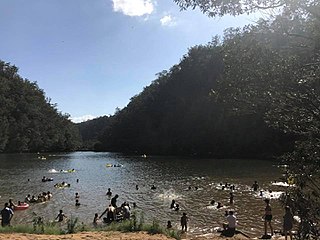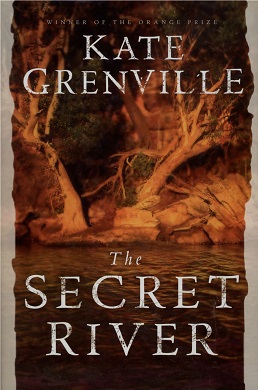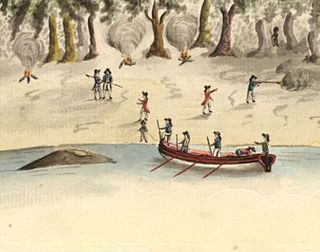Related Research Articles

Western Sydney University, formerly the University of Western Sydney, is an Australian multi-campus public research university in the Greater Western region of Sydney, New South Wales, Australia.

Major General Lachlan Macquarie, CB was a British Army officer and colonial administrator from Scotland. Macquarie served as the fifth Governor of New South Wales from 1810 to 1821, and had a leading role in the social, economic, and architectural development of the colony. He is considered by historians to have had a crucial influence on the transition of New South Wales from a penal colony to a free settlement and therefore to have played a major role in the shaping of Australian society in the early nineteenth century.

The Hawkesbury River, or Hawkesbury-Nepean River, is a river located northwest of Sydney, New South Wales, Australia. The Hawkesbury River and its associated main tributary, the Nepean River, almost encircle the metropolitan region of Sydney. Between Wisemans Ferry and the Pacific Ocean marks the boundary of Greater Metropolitan Sydney in the south and the Central Coast region to the north.

The Colo River, a perennial stream that is part of the Hawkesbury-Nepean catchment, is located in the Central Tablelands of New South Wales, Australia.

Nepean River, is a major perennial river, located in the south-west and west of Sydney, New South Wales, Australia. The Nepean River and its associated mouth, the Hawkesbury River, almost encircles the metropolitan region of Sydney.

The City of Hawkesbury is a local government area of New South Wales, Australia, located on the northern and north-western fringe of the Greater Sydney area, about 50 kilometres (31 mi) north-west of the Sydney central business district. Hawkesbury City is named after the Hawkesbury River.

The South Creek or Wianamatta is a creek that is part of the Hawkesbury-Nepean catchment, located on the Cumberland Plain in Greater Western Sydney, New South Wales, Australia.

The Wollondilly River, an Australian perennial river that is part of the Hawkesbury–Nepean catchment, is located in the Southern Tablelands and Southern Highlands regions of New South Wales. The river meanders from its western slopes near Crookwell, flowing south-east through Goulburn, turning north-east to near Bullio, flowing north-west to Barrallier, before finally heading north-easterly into its mouth at Lake Burragorang.

Bents Basin is a protected nature reserve and state park near Wallacia, New South Wales, Australia in the Sydney metropolitan area. The lake basin, which formed at the efflux of the Nepean River from the Hawkesbury Sandstone gorge, is a popular swimming hole with a camping area and an education centre used by local school groups. Also featuring a large woodland area and native wildlife, the reserve is the only picnic area along the Nepean River and it is one of the most popular water-based picnic parks in Greater Western Sydney.

Pittwater is a semi-mature tide dominated drowned valley estuary, located about 40 kilometres (25 mi) north of the Sydney central business district, New South Wales, Australia; being one of the bodies of water that separate greater Metropolitan Sydney from the Central Coast.
The Macdonald River is a perennial river located in the Hunter and Outer Metropolitan Sydney regions of New South Wales, Australia. It is a part of the Hawkesbury-Nepean catchment.

The Secret River is a 2005 historical novel by Kate Grenville about an early 19th-century Englishman transported to Australia for theft. The story explores what might have happened when Europeans colonised land already inhabited by Aboriginal people. The book has been compared to Thomas Keneally's The Chant of Jimmie Blacksmith and to Peter Carey's True History of the Kelly Gang for its style and historical theme.
John McGarvie was a Scottish-born Australian Presbyterian minister and writer.

Sackville (Doorumbolooa) is a suburb of Sydney, in the state of New South Wales, Australia. It is located in the City of Hawkesbury and at the 2016 census had a population of 298, thirteen of whom identified as Aboriginal and Torres Strait Islander.

The Grose River, a perennial river that is part of the Hawkesbury-Nepean catchment, is located in the Blue Mountains region of New South Wales, Australia.
The Battle of Richmond Hill, also known as the Battle of the Hawkesbury and the Richmond Hill Massacre, was a battle of the Hawkesbury and Nepean Wars, which were fought between the Indigenous Darug people and the New South Wales Corps.

The Hawkesbury and Nepean Wars (1794–1816) were a series of conflicts where British forces, including armed settlers and detachments of the British Army in Australia, fought against Indigenous clans inhabiting the Hawkesbury River region and the surrounding areas to the west of Sydney. The wars began in 1794, when the British started to construct farms along the river, some of which were established by soldiers.
Maria Lock, also known as Maria Locke, was an Aboriginal Australian landowner in the Darug area of Western Sydney. Lock is significant in Australian history due to her educational achievements, having the first legally recognised marriage between a settler and an Aboriginal person, and later for being a landowner in early colonial times.

Grace Elizabeth Karskens, is an Australian historian who is professor of history at the University of New South Wales.
Sackville Reach Aboriginal Reserve was located on the Hawkesbury River near Windsor in New South Wales, established in 1889 by the NSW Aborigines Protection Board. The government of the colony of New South Wales gazetted and revoked land for this community in the Parish of Meehan, County of Cook gazetting AR 23,957, AR 23,958 and AR 28,546.
References
- ↑ Gray, Rachel (8 October 2020). "Uncovering Aboriginal and early settler history along Australia's famous river". UNSW Sydney. Retrieved 29 February 2024.
- ↑ Johnson, Miranda (24 February 2021). "An epic of place where two peoples were transformed". The Sydney Morning Herald. Retrieved 29 February 2024.
- ↑ Irish, Paul (5 October 2020). "People of the River: lost worlds of early Australia". Professional Historians Australia. Retrieved 29 February 2024.
- ↑ Atkinson, Alan (21 October 2020). "Alan Atkinson reviews 'People of the River: Lost worlds of early Australia' by Grace Karskens". Australian Book Review. Retrieved 29 February 2024.
- ↑ Waggoner, Susan (28 May 2021). "Review of People of the River". Foreword Reviews. Retrieved 29 February 2024.
- ↑ Johnson, Miranda (24 February 2021). "An epic of place where two peoples were transformed". The Sydney Morning Herald. Retrieved 29 February 2024.
- ↑ "People of the River: Lost Worlds of Early Australia". State Library of NSW. 20 July 2021. Retrieved 29 February 2024.
- 1 2 3 "Grace Karskens". AustLit: Discover Australian Stories. The University of Queensland. Retrieved 29 February 2024.